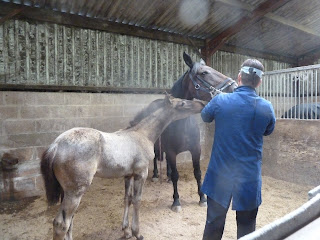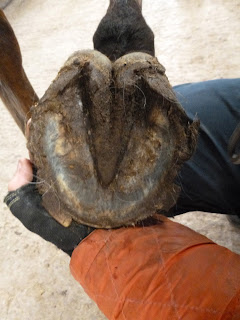Its that time of year again, and after last week's fabulous sunny weather most horse owners are on the watch for foot problems related to grass.
Of course, many horses can tolerate or even do well on quite a lot of grass but - as always - it depends on the horse AND it depends on the grass.
A healthy horse who can safely graze on old, permanent pasture may go footy within hours if turned out on heavily fertilised rye-grass.
And to make matters even more complicated, its not just the type of grass and how its managed that you need to consider. The weather, and even the time of day, can make a difference to sugar levels in grass so that the risk of turning horses out fluctuates considerably.
One way of monitoring how the risk from climate is affecting your grass is to use
the laminitis app. Phil Hunter from
Vizar, who developed the app, explains how it works:
"There has been a lot of discussion on the forums recently about what causes the Laminitis App to show a high risk reading, especially over the past week. Mostly people have been celebrating the arrival of the British summer, enjoying the scorching hot days and long light evenings. For anyone with a horse prone to laminitis, this can be potentially one of the worst times of the year!
Contributing factors over the past week that would result in an increased risk level are: increased daylight hours, clear skies throughout day and night resulting in huge temperature oscillations between day and night. For example some places have seen daytime temperatures in excess of 20ºC and a subsequent fall in temperature down to 4ºC during the early hours of the morning. Whilst this may not be enough to shutdown the grasses' ability to respirate completely, it is still enough to slow things down sufficiently to cause the grass to accumulate NSC. Over the past 2 to 3 weeks there has been an increase in the number of reported cases of horses showing signs of being footy as well as cases of laminitis and colic.
The Laminitis App uses a sophisticated computer model that has been tuned to recognise various weather patterns that have resulted in confirmed laminitis cases. Time and time again whenever a grazing related laminitis case is reported, it can be attributed to a high risk period which had had been predicted by the app. To make this possible weather data from over 300 weather stations located throughout the UK is bought in. This data is updated on an hourly basis and is re-processed using the computer model to provide an up-to-date laminitis risk indicator.
The Laminitis App will default to the nearest weather station to the location you have chosen. If you are monitoring more than one location that are close to one another and have noticed that the risk varies, it is likely that each location is closest to a different weather station.
It is important to note that the app is designed purely as a guide to warn you of weather conditions that you may not have noticed yourself; it should be remembered that green doesn’t necessarily mean ‘safe’ but that the grass is most likely behaving as it does when not under stress – horses vary widely in their ability to tolerate grass therefore owners need to understand and decide for themselves what is ‘safe’ or at risk for their horse."
The app has been very helpful in highlighting the risks to owners and yard managers who were perhaps unaware of how volatile UK grass can be, but its best used as an add-on to a good management programme and your horse is always going to be the ultimate authority on whether the grass is safe for him - or not!
This is a table which I posted last year, giving a general overview of risk levels with grazing. Generally the more of the red factors which apply, the more vigilant you need to be.
Its important to remember too that its much easier to act at the stage when your horse has become slightly footy than to let the problem develop into - at worst case - full blown laminitis.
Take footiness as a warning sign, especially if your horse has previously been sounder, and act quickly. Restrict grazing - if in doubt take your horse off grass completely - and review your feeding plan to ensure that mineral levels are adequate.
I'll assume anyone reading this blog is already aware of the importance of feeding minerals - something like
Progressive Earth's Pro Hoof or Pro Balance - but many horses benefit from additional magnesium oxide and salt at this time of year. Both can safely be given even if you aren't sure whether your horse needs them - and some owners have also reported success with adding sodium bicarbonate to feeds.
Once you have any footiness under control, reintroduce grazing in a controlled manner - for instance using a grazing muzzle, fencing off a track or restricting turn-out to safer times - at night, or using the laminitis app as a guide to when weather factors are less risky.






























































